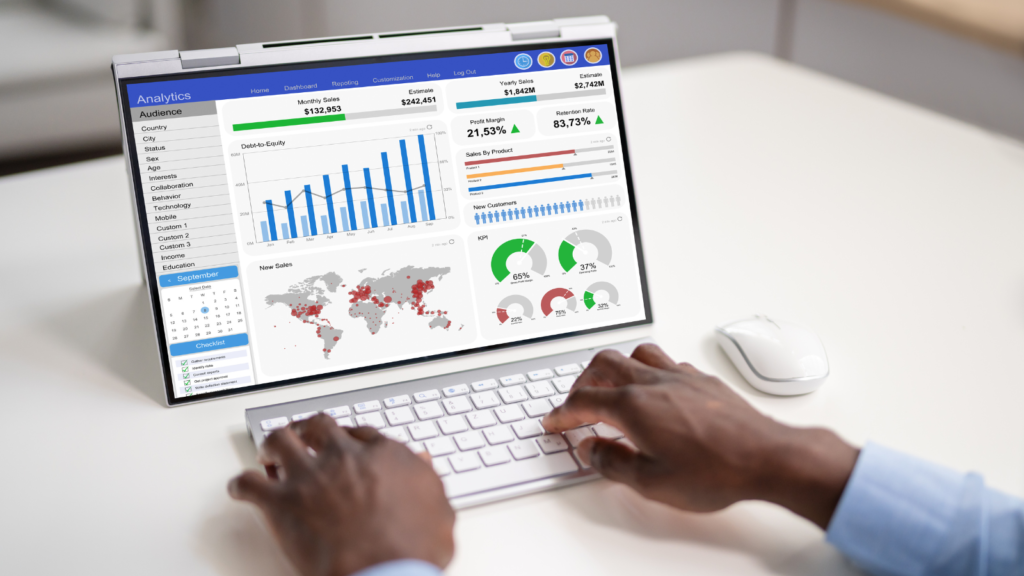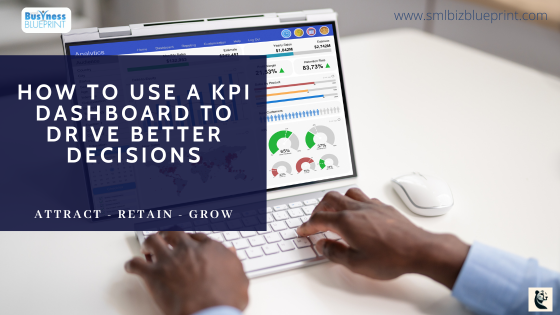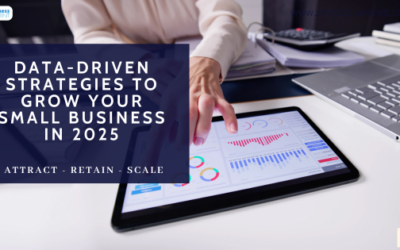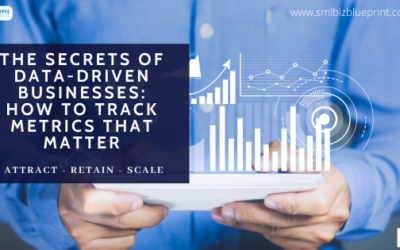If you’ve invested in an AI-powered KPI dashboard to track your business metrics, you’re already a step ahead in making data-driven decisions.
Yet, many business owners and teams are overwhelmed or unsure how to fully leverage their dashboard.
Tracking KPIs is essential, but if your dashboard isn’t providing the insights you need or is too cluttered to navigate, it can feel like just another screen of numbers.
The solution lies in understanding how to set up and use your dashboard strategically.
According to a McKinsey study, businesses that effectively use real-time data are twice as likely to achieve their goals as those that rely on static reports.
This post will show you how to maximise your dashboard’s value with best practices for regularly engaging with, updating, and acting on insights from your data.
From setting up a daily or weekly routine to adjusting KPIs as your business evolves, we’ll guide you through the key steps to making your KPI dashboard a core tool for growth and success.
Let’s explore how to transform your dashboard from a basic tracking tool to a powerful driver for informed, agile decision-making.

#1 Regularly Monitor and Engage with Your Dashboard
To get the most out of your AI-powered KPI dashboard, it’s essential to develop a routine for monitoring and engaging with the data.
A well-built dashboard should provide real-time insights into your business’s key performance metrics, but these insights only become valuable if regularly reviewed and applied.
Set a Dashboard Routine
The first step is to establish a consistent schedule for checking your dashboard.
Depending on your business and the KPIs you’re tracking, this could be daily, weekly, or monthly. For instance:
- Daily Check-Ins: Ideal for fast-moving metrics like sales, website traffic, or customer support response times.
- Weekly Reviews: Useful for tracking metrics with slower changes, such as customer acquisition costs or ad performance.
- Monthly or Quarterly Assessments: Best for strategic metrics, like profit margins or customer lifetime value.
Setting a regular routine ensures that no key trends or shifts go unnoticed.
Many businesses find that incorporating dashboard reviews into team meetings—whether weekly catch-ups or monthly planning sessions—keeps everyone aligned and engaged with the current data.
Dashboards as Decision-Making Tools
The real strength of a KPI dashboard lies in its ability to inform decisions.
A proactive approach to your dashboard means you’re not just observing trends—you’re using those insights to drive action. Encourage your team to use the dashboard as a discussion tool in strategy sessions, planning meetings, and daily operations.
For example, if customer satisfaction scores show a downward trend, it’s an opportunity to identify root causes and adjust customer service strategies before the issue escalates.
Collaborative Data Review
Consider assigning specific team members or departments to take ownership of relevant KPIs.
Sales teams might monitor conversion rates and average order value, while marketing could focus on ad performance and traffic sources. This accountability ensures that each business area stays actively involved with the metrics that matter most to them, creating a culture of data-driven decision-making across your organisation.
#2 Fine-Tuning Your KPIs and Visualization
An effective AI-powered KPI dashboard isn’t static; it adapts to reflect your business’s evolving goals and priorities.
Regularly fine-tuning the KPIs you track and refining how data is visualised helps ensure your dashboard remains relevant, easy to interpret, and impactful.
Adapting KPIs as Business Goals Change
As your business grows and priorities shift, your KPIs should reflect those changes. For example, if you’re in the early stages, you might focus on customer acquisition and traffic growth.
However, metrics like customer retention, lifetime value, or profit margin may become more critical as your business matures. Take the time to review your KPIs quarterly or as significant changes occur in your business strategy.
This ensures that your dashboard continuously aligns with your primary objectives.
Adjusting Visuals for Better Clarity
The way information is displayed on your dashboard can impact how quickly you and your team can interpret it.
Consider the type of data you’re visualising when choosing the most effective format:
- Line Charts: Great for showing trends, such as monthly revenue or customer growth.
- Bar Charts: Ideal for comparisons, like sales by product category or customer acquisition cost by channel.
- Pie Charts: Best for showing proportions, like traffic sources or product category breakdowns.
Try tweaking the visualisations if specific trends aren’t immediately apparent or additional context is needed. Minor adjustments—like colour-coding to highlight performance above or below target—can make a big difference in readability.
Feedback Loop for Continuous Improvement
Creating a feedback loop with the dashboard’s users, especially team members who rely on the insights daily, can reveal valuable improvements.
Ask for input on which KPIs are most helpful, which ones may no longer be needed, and whether additional metrics would add value.
Regular feedback sessions allow you to keep the dashboard efficient and focused on what matters most.
#3 Automating Updates and Refining Data Sources
A truly effective AI-powered KPI dashboard depends on accurate, up-to-date, and easily accessible data.
Automating data updates and routinely reviewing your data sources helps ensure that your dashboard reflects the latest insights, allowing you to make quick, informed decisions without spending time manually updating metrics.
Scheduling Data Refreshes
Automating data updates allows your dashboard to display real-time or near-real-time information. Setting up daily or even hourly refreshes can be valuable for fast-moving KPIs, such as sales numbers or website traffic.
Weekly updates may be sufficient for metrics with slower turnover, like customer acquisition cost.
By automating these refreshes, you reduce the risk of relying on outdated data, and your team can trust that the dashboard’s insights are accurate and timely.
Refining Data Accuracy
While automation keeps data fresh, regular reviews help maintain accuracy. Check data sources periodically to ensure there are no discrepancies or misaligned metrics.
For example, if you pull data from multiple systems—such as CRM tools, Google Analytics, or accounting software—verify that all sources are synced correctly and that data is displayed consistently across platforms.
Inaccurate data can lead to misinformed decisions, so prioritise accuracy checks as part of your dashboard routine.
Real-Time Alerts and Adjustments
Consider setting up real-time alerts that notify you when KPIs deviate significantly from their expected values. For instance, an alert can be configured to trigger if website traffic suddenly drops or if customer complaints exceed a certain threshold.
These AI-powered alerts enable you to respond proactively to issues and make quick adjustments to prevent further impact.
You can address problems before they escalate by catching anomalies as they happen.

#4 Taking Action on Dashboard Insights
Having a regularly updated and refined AI-powered KPI dashboard is only valuable if you actively use the insights to make strategic decisions.
The dashboard should be more than just a tool for monitoring metrics—it should guide actions, adjustments, and proactive planning based on real-time data.
Analysing Trends and Patterns
One of the most powerful aspects of a well-maintained dashboard is its ability to reveal patterns and trends over time.
Analysing trends—such as seasonal sales cycles, customer engagement fluctuations, or shifts in conversion rates—can help you anticipate future changes and prepare accordingly. Identifying these patterns allows your team to adjust marketing campaigns, optimise inventory, or enhance customer service based on predictable cycles.
Scenario Planning and Forecasting
Leverage your dashboard’s AI and predictive analytics capabilities to create scenarios and forecasts.
By visualising potential outcomes based on historical data, you can make informed decisions about possible changes in the market or your business environment.
For instance, an e-commerce company might use historical sales data and current trends to forecast demand for specific products, allowing for better inventory planning during peak seasons.
Creating Action Plans Based on KPIs
An effective dashboard helps translate insights into actionable steps. When a KPI trend indicates that action is needed, outline a specific plan to address it.
For example:
- If customer satisfaction dips: Review recent support interactions, analyse response times, or consider increasing support resources.
- If website traffic rises but conversions lag: Examine page load times, review call-to-action effectiveness, or refine the user journey.
- If ad performance drops: Reassess the ad creative, adjust targeting parameters, or allocate budget to better-performing campaigns.
Turning data into clear actions keeps your team focused and ensures the dashboard remains a practical, results-driven tool rather than just a passive display of metrics.
#5 Continuous Improvement and Scalability
A KPI dashboard is not a “set it and forget it” tool—it’s a dynamic resource that evolves with your business.
As your team grows, goals shift, and new challenges arise, maintaining a culture of continuous improvement ensures your dashboard remains a powerful asset.
Regularly updating, refining, and scaling your dashboard allows it to meet changing needs and provides more value over time.
Iterating and Improving
Regularly review the effectiveness of the KPIs you’re tracking and the visualisations you’re using.
Are there metrics that no longer provide meaningful insights?
Are there new KPIs that could add value as your business objectives evolve?
Make a habit of removing outdated metrics and adding relevant ones. Small improvements—such as enhancing colour coding for visual clarity or repositioning key KPIs—can make the dashboard easier to interpret and more actionable for your team.
Scaling the Dashboard for Team Growth
As your business expands, your dashboard should adapt to support new departments, teams, and goals.
For example, a growing business may need to incorporate department-specific KPIs, such as customer service response times for support teams or social media engagement metrics for marketing.
Scaling your dashboard effectively can help each team within your organisation access the metrics they need, fostering a data-driven culture across the company.
Training and Onboarding
For a dashboard to deliver its full value, all team members must understand how to use it effectively. When new employees join, or team roles evolve, ensure they receive comprehensive training on navigating and interpreting the dashboard.
By building familiarity with key KPIs and how to act on them, you empower your team to leverage data in everyday decision-making.
Consider offering tutorials, video walkthroughs, or regular onboarding sessions to keep everyone aligned.
Conclusion
An AI-powered KPI dashboard can transform how your business tracks progress, adapts to change and drives growth.
By following best practices—setting up regular check-ins, refining your KPIs, automating data updates, and acting on insights—you’ll turn your dashboard into more than just a display of numbers; it becomes a strategic tool for informed decision-making.
Remember, a well-designed dashboard is flexible and evolves with your business.
As your team grows, so too should your dashboard’s capabilities.
Regular improvements, from adjusting visualisations to onboarding new team members, ensure that your dashboard continues to serve as a reliable guide in your daily operations and long-term planning.
Ready to take the next step?
Start implementing these practices today to unlock the full potential of your KPI dashboard.
Whether you’re refining KPIs or scaling your dashboard for a growing team, each step brings you closer to a data-driven culture where insights back every decision.
Let your dashboard be the engine that powers your business forward.
FAQs
Q1: How often should I check my KPI dashboard?
A1: The frequency depends on the metrics you’re tracking. Fast-changing KPIs, like sales or website traffic, may require daily check-ins, while more strategic KPIs, like customer lifetime value, can be reviewed weekly or monthly.
Q2: How do I choose the right KPIs for my dashboard?
A3: Start with your business goals. Identify KPIs that directly support those objectives. For example, if your focus is customer growth, track metrics like conversion rates, acquisition cost, and customer retention.
Q3: What’s the benefit of automating data updates in my dashboard?
A3: Automating updates ensures real-time accuracy and saves time. With automation, your team can rely on up-to-date insights without manually refreshing data, enabling faster, data-driven decisions.
Q4: How can I improve the readability of my dashboard?
A4: Use simple, clear visualisations tailored to each metric type. Line charts work well for trends, while bar charts are useful for comparisons. Colour-coding and simplifying the layout can also improve readability.
Q5: How do I keep my dashboard relevant as my business grows?
A5: Regularly review and adjust the KPIs and visuals to reflect changing business goals. As new priorities emerge, update the dashboard to include metrics that support these objectives, and remove outdated ones.
Q6: Can I use my dashboard to forecast and plan for different business scenarios?
A6: Yes, many AI-powered dashboards offer predictive analytics, allowing you to simulate different scenarios and forecast trends. This helps with proactive planning and makes your dashboard a more strategic tool.
Q7: How do I ensure my team uses the dashboard effectively?
A7: Provide training for team members on how to interpret and act on the data. Regular onboarding, tutorials, and feedback sessions help integrate the dashboard into daily decision-making and ensure everyone gains value from it.
Other Articles
Measuring Your Marketing Success: Evaluating Outcomes for Growth




